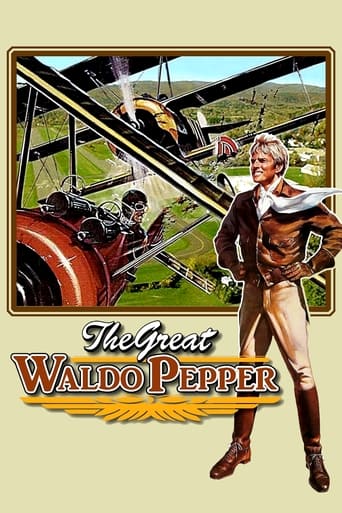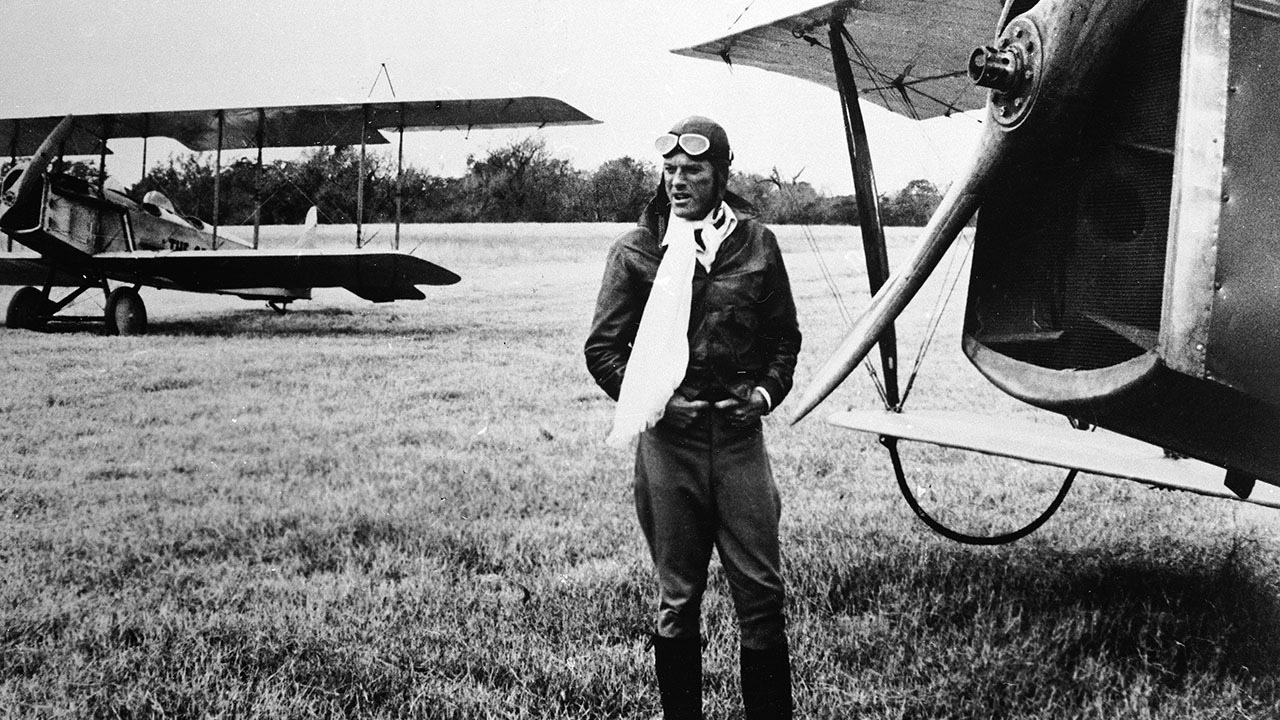bkoganbing
Robert Redford got one of his best roles in The Great Waldo Pepper which was directed by George Roy Hill who did right by him with Butch Cassidy And The Sundance Kid and The Sting. It does a wonderful job of capturing a bygone era of the Twenties when after World War I, the airplane was a big toy played with by some big kids.The airplane got invented just in time for use in the war to end all wars. But no one figured out quite what to do with it. In point of fact it didn't have the capacity to drop bombs on the enemy to do that much damage. In the trench warfare days the real function was scouting those enemy lines to see and report on troop dispositions. But the other side did the same thing. So when they met dogfights happened. They were colorful and exciting, but didn't really do much militarily.Aces got their reputations like the real life Baron Von Richtofen and Hermann Goering and the fictional Ernest Kessler as played by Bo Brundin here. Waldo Pepper in the Great War came up too late to show his stuff even though his former squadron leader Geoffrey Lewis says he was the most natural flier he ever saw. He had a brief encounter with Brundin days before the Armistice where Brundin let him off. He never got a chance to prove himself. Now he proves himself every day in the various flying circuses doing daredevil stunts. People who fly do it for the love it and won't be happy going 9 to 5 on the ground. Redford is at the height of his abilities and this is his frustration that he never got to show his stuff in the arena where it really counted. Redford did a wonderful job in fleshing this aspect of his character.But his world is changing, if the military has put aviation on hold there are lots of commercial uses. And a guy named Herbert Hoover who Secretary of Commerce at that time spearheaded the creation of the Civil Aeronautics Agency to regulate air traffic. Airplanes would be hauling mail and people and would soon be large enough to haul freight. Not a world that calls for daredevil daring.The Great Waldo Pepper is one of Robert Redford's best films and roles. The Great Robert Redford has this part really nailed down. Some other folks in the cast are a tragic Edward Herrmann who hasn't got the skill as a pilot that Redford has and shows it. Susan Sarandon plays a budding wing walker who also perishes tragically in one of her early roles. George Roy Hill assembled a great supporting cast to back up Redford.In the end it's Redford who makes The Great Waldo Pepper great.
Mathias Nagy (rocdoc2004)
Watching all these wonderful actors in their prime, the great storyline and the great cinematography for the first time has had me enthralled. This is a really enjoyable film with considerable depth. In my mind it is an exploration of the competitive nature of the flyers themselves - whether friends or rivals, one soon becomes acutely aware of their constant need to push their limits, not only amongst themselves but also within themselves. For some reason this film is only averaging a rating of 6.4, and it deserves much more than that, so my vote will hopefully help to reflect a more appropriate rating for what is a really enjoyable movie.Even if you are not into aviator flicks, you will enjoy this movie - it is an excellent example of the filmmakers and scriptwriters art. I give it my heartiest recommendation.
James Hitchcock
Now that flying seems such a mundane, everyday way of getting people from A to B, it is strange to recall that there was a time, not so long ago, when it seemed far more magical. In the twenties and thirties aviation represented what space travel came to represent during my childhood in the sixties and seventies- mankind's most thrilling new adventure. The aviator-poet John Magee was able to write in his sonnet "High Flight" that while flying he had "slipped the surly bonds of Earth" and "put out my hand, and touched the face of God"."The Great Waldo Pepper" is a film which, like the more recent "The Aviator", captures some of the excitement of those days. It is set in the world of the "barnstormers", troupes of pilots who would perform stunts to entertain the crowds. This was a popular form of entertainment in the 1920s, and many of the barnstormers were former fighter pilots from the First World War; the troupes became known as "flying circuses", after the squadron commanded by Manfred von Richthofen, Germany's greatest ace. At first their stunts were relatively simple ones, but as time went on the crowds became more demanding and the pilots were expected to perform increasingly dangerous manoeuvres, sometimes verging on the suicidal. The proprietor of the "flying circus" featured in the film puts it simply. "I'm not selling good flying. I'm selling sudden death." The film charts the exploits of the title character and his two great rivals, Axel Olsson (an American but presumably originally from Scandinavia, to judge from his accent) and Ernst Kessler (a German loosely based upon another real-life flying ace, Ernst Udet). Pepper's rivalry with these two men stems from the fact that they both had distinguished combat records during the war, whereas he served in the American forces but was employed as an instructor and never saw active service. (His rivalry with Olsson, however, does not prevent them from becoming close friends).At the beginning of the 1920s flying was an almost entirely unregulated activity, but during the decade it became more commercialised as the first airlines and air mail services were launched and tighter regulations were introduced in the interests of public safety. After a young woman is killed in a dangerous stunt that goes wrong, Pepper loses his pilot's licence and is forced to abandon barnstorming. He is, however, unwilling to give up flying altogether, and travels to Hollywood where he becomes a stunt pilot under an assumed name. He learns that Kessler and he are both working on the same film, a wartime aviation drama, and that they are due to re-enact a famous dogfight between British and German planes. Somehow, they manage to turn their film sequence into a real-life duel.The film was directed by George Roy Hill and starred Robert Redford, who had previously worked with Hill in "Butch Cassidy and the Sundance Kid" and "The Sting". (Unlike those two films, however, this one does not co-star Paul Newman). One of Redford's greatest assets as an actor was his amiable, boyish charm, and that is much in evidence in this film, especially during the more comic first half. He plays Pepper as charming and debonair, with an insouciant, devil-may-care attitude, in contrast to the more level-headed Olsson and the gloomy, saturnine Kessler. Kessler has fallen on hard times after Germany's defeat; his pessimistic attitude is due to the fact that he was a hero in wartime but has become a nobody in peacetime. (Something similar happened to the real Udet, who went on to join the Nazis and ended up committing suicide). His character comes more to the fore in the second half of the film which is notably darker than the light-hearted early scenes.There are excellent performances from Redford and from Bo Brundin as Kessler. (Olsson is played by Bo Svenson; are there any other English-language films where two major male characters are played by actors named Bo?) The main attraction of the film, however, is not the acting but the magnificent flying sequences, all of which were performed using real aircraft, not models or special effects. (It is said that the actors performed all their own stunts, including wing walking, which must have given the film's insurers some nervous moments). It is these exhilarating scenes which give the film its excitement and much of its emotional power, making it a fitting tribute to the pioneers of aviation. 7/10
Patrick McCormick (splat99)
I first saw this film in the theater almost 30 years ago and have caught it a few times on TV since. Finally, I was able to find a DVD copy on E-Bay (apparently it is not currently available on DVD through normal means) and I am glad I did so. This movie has stood the test of time. It is both fun to watch and has some depth to it - it is not just a piece of fluff. The casting is excellent - not a single actor is unfit for the part. Redford's looks and charisma, coupled with the fact that while he is still pretty young he does have a few visible age lines, make him perfect for the part of a debonair flyboy, ten years removed from World War I, who is stubbornly resisting the increasing regulation of flying as a profession. Bo Svensen is a great complement as the slightly older, more experienced, and more even-keeled Axel Olsson. Geoffrey Lewis' Newt Potts, Pepper's old squadron commander, represents the future that Pepper is trying to avoid. Ed Herrmann is the embodiment of the "seat of your pants" spirit of the early aircraft producers. Phil Bruns is a convincing "carnival barker" as Doc Dillhoeffer. And the Swedish actor Bo Brundin puts in a great turn as Ernst Kessler, German fighter ace turned barnstormer, who has long since realized that the bravery and chivalry he found in the air (both among comrades and opponents) is rarely found on the ground. Kessler is based on Ernst Udet, the second-highest scoring German ace of WWI. Udet barnstormed after the war, had a shortened version of "Lola" painted on his Fokker D-VII, and had a fight similar to the epic battle that is an important subplot in the movie. Thus it is a nice touch that Udet is shown in the opening photo montage. (It's also good that no sequel was made - I'd hate to see the Kessler character return to Germany, join Hitler's Luftwaffe and commit suicide.) This is also notable, on a personal level, as the first place I ever saw Susan Sarandon. I've been a fan ever since. Hell, she still looks great. The flying sequences are magnificent. There's no CGI here, folks. These are real aircraft - beautiful replicas of Curtiss Jennies, Standard E-4's, and of course the Sopwith Camel and Fokker Triplane (plus a few others) - doing real stunt flying. The talented stunt pilots are credited under the umbrella of Tallmantz Aviation, which I'm guessing was formed by legendary stunt pilots Frank Tallman and Paul Mantz. Tallman himself flew in this film (and died in a crash three years later; Mantz died making "Flight of the Phoenix," another of my favorite flight movies, in 1965.) And the climactic sequence, while it may seem unlikely to some, is actually based (perhaps loosely) on a similar incident that occurred during the filming of either "Hells' Angels" or "Wings" in the late 1920's. The only possible anachronism that I can spot is Kessler's stunt plane, which looks a little too advanced for 1928. But I could be wrong there. Beautiful aircraft, great flying sequences, fine acting, and even a real plot - what more could you want?



 AD
AD




